Adlestrop
Adlestrop (/ˈædəlstrɒp/; formerly Titlestrop or Edestrop) is a village and civil parish in Gloucestershire, England. It is recorded as Tedestrop in the Domesday Book. The name means "village of a person called Adel", with the Old English suffix thorp, which here has become "trop".[1] In the 2011 census, it had a population of 120.
| Adlestrop | |
|---|---|
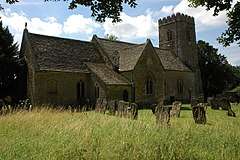 St. Mary Magdalene Church | |
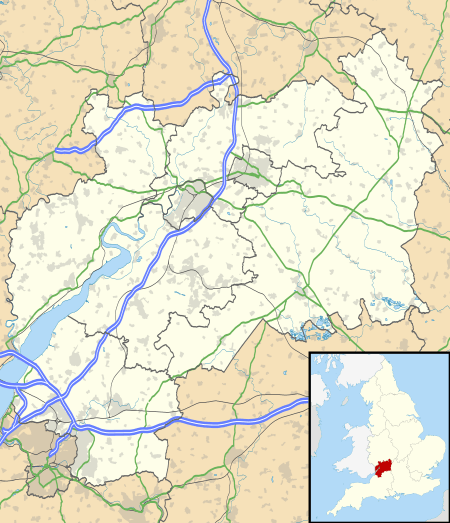 Adlestrop Location within Gloucestershire | |
| Population | 120 (2011 Census) |
| District | |
| Shire county | |
| Region | |
| Country | England |
| Sovereign state | United Kingdom |
| Post town | Moreton-in-Marsh |
| Postcode district | GL56 |
| Police | Gloucestershire |
| Fire | Gloucestershire |
| Ambulance | South Western |
| UK Parliament | |
Description
This small Gloucestershire village deep in the heart of the Cotswolds is renowned for its surrounding countryside and fine walks. Situated off the main A436 road between Stow-on-the-Wold and "The Greedy Goose" near Salford, Oxfordshire, it is a geographically isolated community, with the village post office near the church being the main source of provisions and physical communication. Adlestrop's cricket club plays at Adlestrop Park.[2]
Literary associations

The novelist Jane Austen visited Adlestrop House, formerly the rectory, at least three times between 1794 and 1806, when the occupant was Rev. Thomas Leigh, her mother's cousin. She is thought to have drawn inspiration from the village and its surroundings for her novel Mansfield Park.[3]
Adlestrop was immortalised by Edward Thomas's poem "Adlestrop", which was first published in 1917. The poem describes an uneventful journey that Thomas took on 24 June 1914 on the Oxford to Worcester express; the train made a scheduled[4] stop at Adlestrop railway station, although this was, from the poet's point of view, an unscheduled stop. He did not alight from the train, but describes a moment of calm pause in which "a blackbird sang close by, and... all the birds of Oxfordshire and Gloucestershire". The station closed in 1966; however, the village bus shelter contains the station sign and a bench that was originally on the platform. A plaque on the bench quotes Thomas’s poem. These are the only things that remain of the original station.[5]
Adlestrop
Yes. I remember Adlestrop
The name, because one afternoon
Of heat, the express-train drew up there
Unwontedly. It was late June.
The steam hissed. Someone cleared his throat.
No one left and no one came
On the bare platform. What I saw
Was Adlestrop—only the name
And willows, willow-herb, and grass,
And meadowsweet, and haycocks dry,
No whit less still and lonely fair
Than the high cloudlets in the sky.
And for that minute a blackbird sang
Close by, and round him, mistier,
Farther and farther, all the birds
Of Oxfordshire and Gloucestershire.
Church bells
The five bells of the church of St. Mary were last all rung together in about 1975. The bells lay unrung completely until 2007, when two local couples wishing to marry asked for bells to be rung at their weddings. The bells are:
- Treble (smallest bell), note F: cast in 1711 by Abraham Rudhall (Gloucester)
- 2nd bell, note E flat: cast in 1711 by Abraham Rudhall
- 3rd bell, note D: cast in 1711 by Abraham Rudhall
- 4th bell, note C: cast in 1711 by Abraham Rudhall
- Tenor (largest bell), note B flat (but cracked and toneless): cast in 1838 by Thomas Mears (Gloucester).
The Adlestrop bells are hung in the traditional English fashion. Over the years, the bell-frame became time expired, as it suffered from dry rot and woodworm infestation. Even the four uncracked bells could be rung only very cautiously and were officially listed as "unringable". Following a successful appeal to re-hang the bells and make them fully ringable, the restored bells and frame were rung once again in May 2016.[6]
Notable people
- Cecil Fiennes (1831–1870), cricketer
- Wingfield Fiennes (1834–1923), cricketer
Gallery
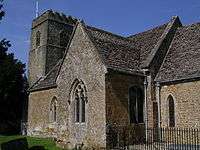 Church of St Mary Magdalene
Church of St Mary Magdalene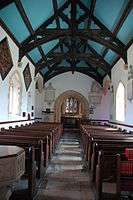 Interior of Church of St Mary Magdalene
Interior of Church of St Mary Magdalene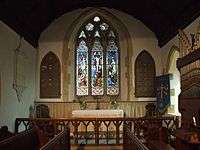 East window and altar, Church of St Mary Magdalene
East window and altar, Church of St Mary Magdalene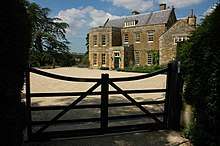 Adlestrop House, formerly the rectory
Adlestrop House, formerly the rectory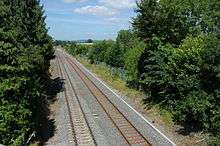 Site of Adlestrop railway station
Site of Adlestrop railway station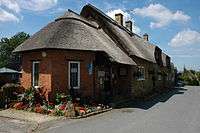 Village shop in Adlestrop
Village shop in Adlestrop
References
- Reaney, P. H. (1980). The Origin of English Place-Names. Routledge and Kegan Paul. p. 174.
- "Adlestrop Cricket Club". Archived from the original on 1 July 2012. Retrieved 4 July 2010.
- Adlestrop, Gloucestershire at astoft2.co.uk Archived 12 March 2007 at the Wayback Machine
- Adlestrop, by Edward Thomas Bruno Derrick, 22 November 2012 blog.nationalarchives.gov.uk accessed 18 June 2020
- "100 Years Ago A Train Stopped at Adlestrop Station". Adlestrop village website. Retrieved 28 August 2016.
- "Dedication service to celebrate success of St Mary Magdalene Adlestrop church bell project". Hereford Times. 26 July 2016. Retrieved 22 August 2016.
Further reading
- Harvey, Anne (compiler & editor) (1999) Adlestrop Revisited: an Anthology Inspired by Edward Thomas's Poem, Stroud: Sutton Publishing ISBN 0-7509-2289-3
Huxley, Victoria, Jane Austen & Adlestrop: Her Other Family (2013) Gloucestershire, Windrush Publishing, ISBN 978-0-9575150-2-4
External links
| Wikivoyage has a travel guide for Adlestrop. |
| Wikimedia Commons has media related to Adlestrop. |
- Adlestrop and the Cotswolds
- Adlestrop Rectory
- St. Mary Magdalene Church, Adlestrop
- Adlestrop visited by Joseph Gelfer
- 'Parishes: Adlestrop', A History of the County of Gloucester: volume 6 (1965), pp. 8-16.
- Adlestrop: historical and genealogical information at GENUKI.
- Adlestrop in the Domesday Book